The most effective times for red light therapy before bed work with your body's natural rhythms. You'll get the best results using a 10-20 minute session right after dinner (around 6-7 PM), during your evening relaxation time (7-8 PM), or 30-60 minutes before sleep (9-10 PM). For shift workers, schedule your session 1-2 hours before your planned bedtime, regardless of the hour. If you're dealing with seasonal changes, add a fifth session in the early evening (5-6 PM) to regulate your circadian rhythm. Understanding the science behind these timing windows can maximize your therapy's sleep-enhancing benefits.
Benefits Beyond Better Sleep
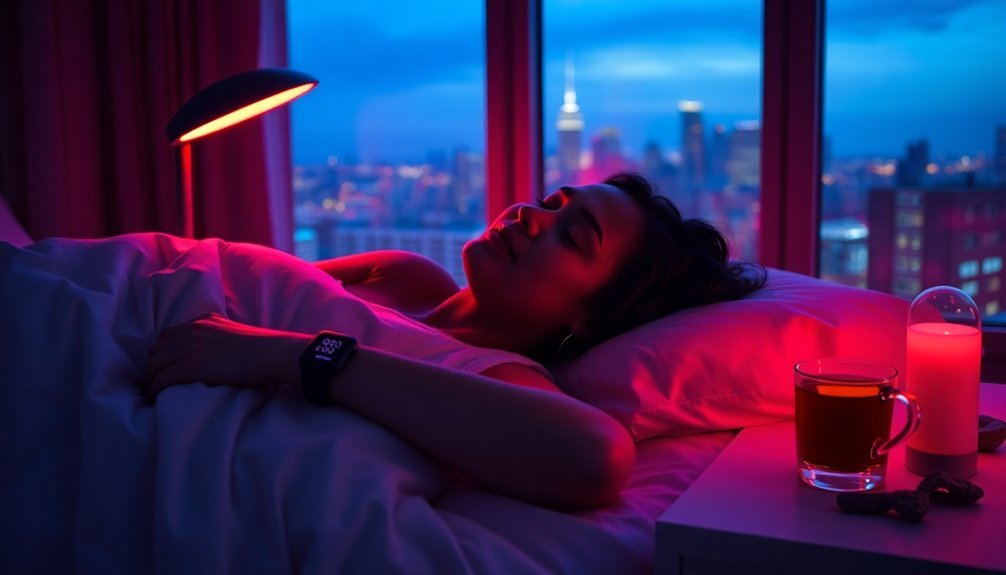
While most people turn to red light therapy for sleep improvement, its remarkable benefits extend far beyond a good night's rest. You'll experience reduced stress and anxiety as the therapy stimulates endorphin production, your body's natural mood enhancers. It's particularly effective at modulating brain activity and neurotransmission, helping you build better stress resilience.
You'll notice improved circulation and energy levels as red light therapy boosts your cellular metabolism and ATP production. It stimulates your mitochondria, enhancing your body's natural healing abilities and helping you recover from physical stress more effectively. Red light therapy supports tissue repair and regeneration during your rest period. The therapy also increases blood flow to your skin and tissues, promoting overall health and vigor.
Your mood and cognitive function will likely improve too. Studies show significant reductions in depression and anxiety scores after red light therapy sessions. The treatment enhances your vagal nerve activity and parasympathetic tone, contributing to better relaxation and mental clarity.
You'll also benefit from reduced oxidative stress as the therapy increases your body's production of natural antioxidants like glutathione and superoxide dismutase, helping protect your cells from damage and aging.
Understanding Red Light Sleep Cycles
Your body's natural melatonin production follows a predictable pattern that peaks in the evening and diminishes by morning.
Red light therapy can enhance this natural cycle by mimicking the sunset's wavelengths, which triggers your brain to start producing more melatonin.
When you shift from bright daylight to red light in the evening, you're supporting your body's natural circadian rhythm and creating ideal conditions for restorative sleep.
Using red light therapy for 10-20 minute sessions provides optimal benefits without overstimulating your system before bedtime.
Melatonin Production Timing Patterns
The body's melatonin rhythm follows a predictable 24-hour cycle, reaching its peak production between 3 to 4 AM and its lowest levels during daylight hours. You'll notice your sleep drive increasing about two hours before your regular bedtime, which coincides with your natural melatonin secretion. The conversion process involves serotonin to N-acetylserotonin before becoming melatonin.
| Time of Day | Melatonin Level | Recommended Action |
|---|---|---|
| Morning | Lowest | Bright light exposure |
| Afternoon | Minimal | Normal activities |
| Evening | Rising | Red light therapy |
| Night | Peak | Deep sleep phase |
Your suprachiasmatic nucleus (SCN) orchestrates this intricate timing, responding primarily to light exposure throughout the day. When you're exposed to sunlight during morning hours, you're helping to calibrate your internal clock. As evening approaches, you'll want to reduce bright light exposure and introduce red light therapy 1-2 hours before bedtime for 15-30 minutes. This timing aligns perfectly with your body's natural melatonin production cycle.
If you're using red light therapy to enhance your sleep, you'll get the best results by maintaining consistent timing. Your pineal gland responds most effectively to this routine when it's synchronized with your natural circadian rhythm.
Natural Light Transition Effects
Natural light patterns play a powerful role in regulating sleep cycles, building upon the melatonin production patterns we just explored. Your body responds directly to light wavelengths, with morning sunlight exposure helping to synchronize your internal clock and evening light potentially disrupting your sleep phase shifts. Total darkness during sleep is essential for optimal rest quality.
When you expose yourself to natural daylight early in the day, you'll notice improved sleep quality and an easier time falling asleep at night. However, artificial light exposure in the evening can interfere with your body's natural sleep-wake rhythm, making it harder to shift between sleep cycles.
- Aim for 15-30 minutes of morning sunlight exposure to advance your sleep timing and enhance overall sleep quality
- Reduce artificial light exposure 2-3 hours before bedtime to maintain healthy sleep patterns
- Use red light therapy 30 minutes before bed to counter any residual blue light effects
- Maintain consistent light exposure patterns to help establish a regular sleep rhythm
Understanding these natural light phase shifts helps you optimize your red light therapy timing and maximize its sleep-enhancing benefits. The key is working with your body's natural circadian rhythm while minimizing disruptive light exposure when it matters most.
Post-Dinner Therapy Window
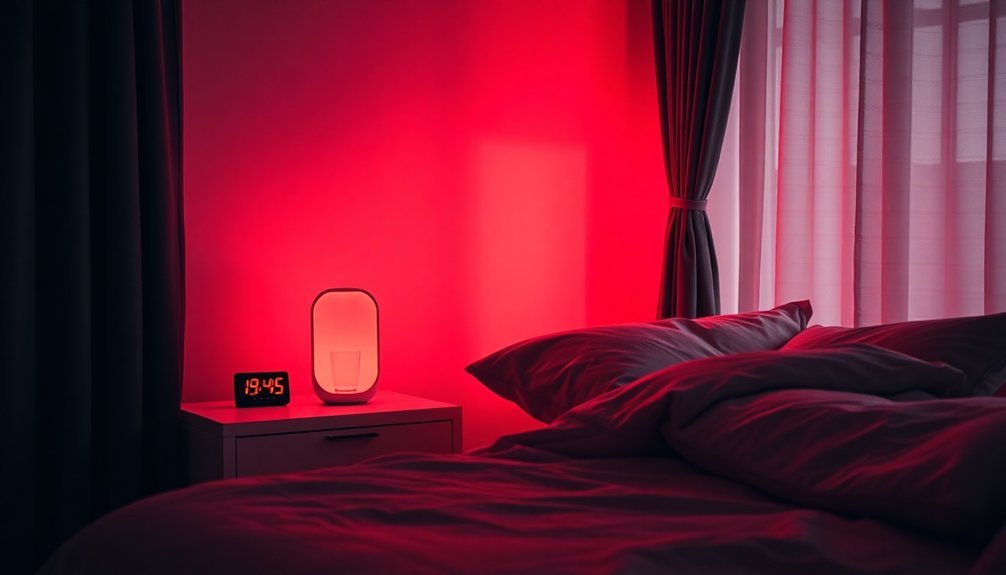
Ideal timing for red light therapy falls within a critical post-dinner window, specifically 30 minutes before bedtime. You'll maximize sleep benefits by maintaining consistency with this timing, as it helps regulate your circadian rhythm and signals your brain to prepare for rest.
| Timing Factor | Benefit |
|---|---|
| 30-min Pre-bed Window | Ideal melatonin production |
| Evening Sessions | Counteracts blue light exposure |
| 10-20 Min Duration | Prevents overstimulation |
| Post-Dinner Timing | Enhanced metabolic benefits |
| Consistent Schedule | Establishes sleep rhythm |
During your evening therapy window, you'll want to create a calm environment with dimmed lights to enhance the treatment's effectiveness. Finding the right emotional balance is crucial for optimal results, just as in traditional therapy settings. The therapy works by stimulating your cellular processes and promoting better circulation while helping your hypothalamus produce melatonin. You'll notice improvements in sleep quality and cognitive performance with regular sessions.
For best results, combine your therapy with relaxation techniques like deep breathing. The red light helps release serotonin, improving your sleep quality, regulating your appetite, and fostering a positive mindset. You'll also benefit from reduced inflammation and improved vascular health, making this post-dinner window vital for your overall wellness routine.
Evening Relaxation Sweet Spot
Finding your perfect evening relaxation sweet spot requires understanding the delicate balance between timing and environment. You'll want to schedule your red light therapy session approximately 1-2 hours before bedtime to maximize its sleep-enhancing benefits.
This timing allows your body to naturally shift into its rest phase while supporting your circadian rhythm regulation. Take time to close your eyes gently and settle into a peaceful state before beginning your session.
Position yourself about 2 feet away from your red light therapy device in a dimly lit room to create the ideal relaxation environment. If you have sensitive eyes, consider using the device while lying on your back.
For best results, aim for a 10-minute session, making sure to maintain consistency by incorporating therapy 3-7 times per week.
- Combine your therapy with deep breathing exercises or meditation to enhance relaxation
- Listen to soothing music or engage in light reading during your session
- Keep ambient lighting low to complement the red light's calming effects
- Practice gentle evening yoga before or after your therapy session
Remember that consistency is key – maintaining a regular schedule with your red light therapy will lead to more substantial improvements in your sleep quality over time.
Nighttime Melatonin Enhancement Strategy
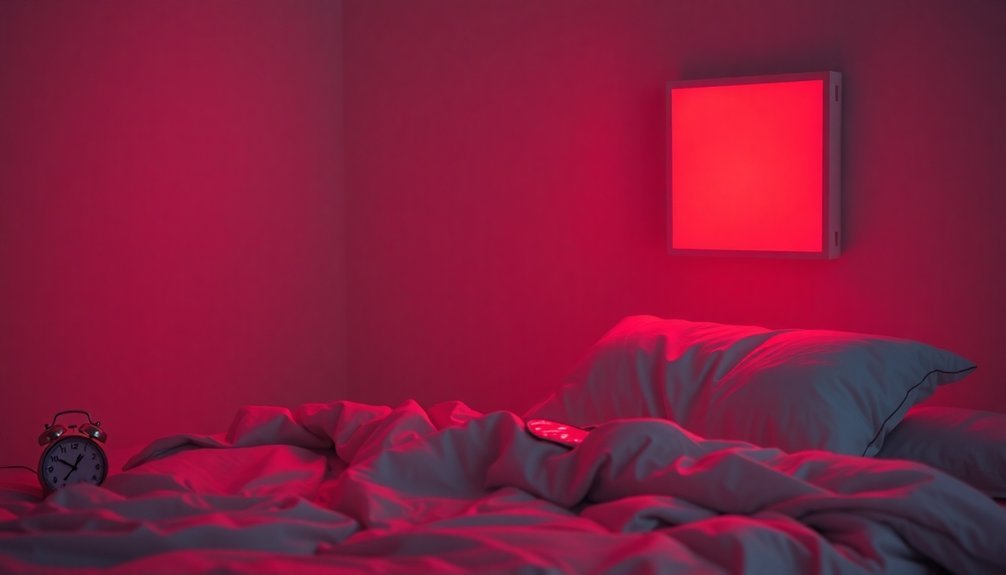
Your body's natural melatonin production reaches its peak when you create the right environmental conditions through strategic light exposure.
You'll boost your nighttime melatonin levels by getting bright light during the day and dimming your lights 90 minutes before bed, while using red light therapy can further enhance this natural process. These practices help prepare your body for sleep as melatonin levels naturally rise about two hours before your usual bedtime.
Maximize Melatonin Production Naturally
Optimizing your body's natural melatonin production doesn't require supplements when you understand the right combination of foods and activities. Your evening routine can substantially boost melatonin levels by incorporating specific foods and creating the right environment for sleep. Getting natural sunlight during daytime hours helps your body produce adequate serotonin, which is essential for nighttime melatonin production.
Start by choosing foods rich in natural melatonin, such as pistachios, tart cherries, and mushrooms. Combine these with tryptophan-rich options like turkey, milk, or bananas to enhance serotonin production, which converts to melatonin. Whole grains and sprouted lentils can further support your body's natural melatonin synthesis.
Tips for Boosting Melatonin
- Time your meals strategically – consume tryptophan-rich foods 2-3 hours before bedtime to maximize melatonin secretion.
- Use red light therapy in the evening to stimulate natural melatonin production.
- Take a warm bath to relax your body and enhance melatonin levels.
- Avoid artificial light and exercise close to bedtime, as they can disrupt your body's natural melatonin rhythm.
Remember to dim lights in the evening and create a sleep-friendly environment. You'll find that these natural methods can effectively boost your melatonin levels without relying on synthetic supplements.
Support Circadian Light Response
Managing your light exposure throughout the day plays a critical role in regulating your body's natural melatonin production. You'll want to expose yourself to bright daylight in the morning and afternoon, as this helps program your body to produce melatonin at the right time later in the evening.
As night approaches, you'll need to carefully manage your light exposure to support your circadian rhythm. Blue light from electronic devices and bright overhead lighting can substantially suppress your melatonin production, so it's essential to minimize these sources in the evening hours. Instead, switch to dim red lights, which won't interfere with your body's natural melatonin secretion.
Red light therapy before bed offers particular benefits for your sleep-wake cycle. Unlike blue light, red light won't disrupt your melatonin production and can actually help counteract any previous blue light exposure.
You'll find that red light therapy promotes relaxation and can improve your overall sleep quality. For the best results, establish a consistent schedule for your red light therapy sessions and combine this with good sleep hygiene practices, such as maintaining regular bedtimes and limiting stimulating activities in the evening.
Optimal Duration Guidelines
The timing of red light therapy sessions plays a crucial role in maximizing sleep benefits. For the best results, you'll want to engage in sessions lasting between 10-20 minutes, positioning your device 6-12 inches from your face and upper body.
When you're new to red light therapy or particularly sensitive to light, start with shorter 3-minute sessions and gradually increase the duration as your body adjusts.
Consistency matters more than duration, so it's better to maintain regular shorter sessions than sporadic longer ones. You'll get the most benefit by incorporating red light therapy into your evening routine, ideally 30 minutes before bedtime, allowing your body to naturally wind down and boost melatonin production.
- Use red light therapy for 3-10 minutes if you're just starting out
- Extend sessions to 10-20 minutes once you're comfortable with the therapy
- Position your device 6-12 inches away for ideal exposure
- Maintain consistency by using the therapy 3-7 times per week
Remember to listen to your body's response and adjust the duration accordingly. If you're using the therapy for sleep improvement, avoid extended sessions that might overstimulate your system.
After Exercise Recovery Period
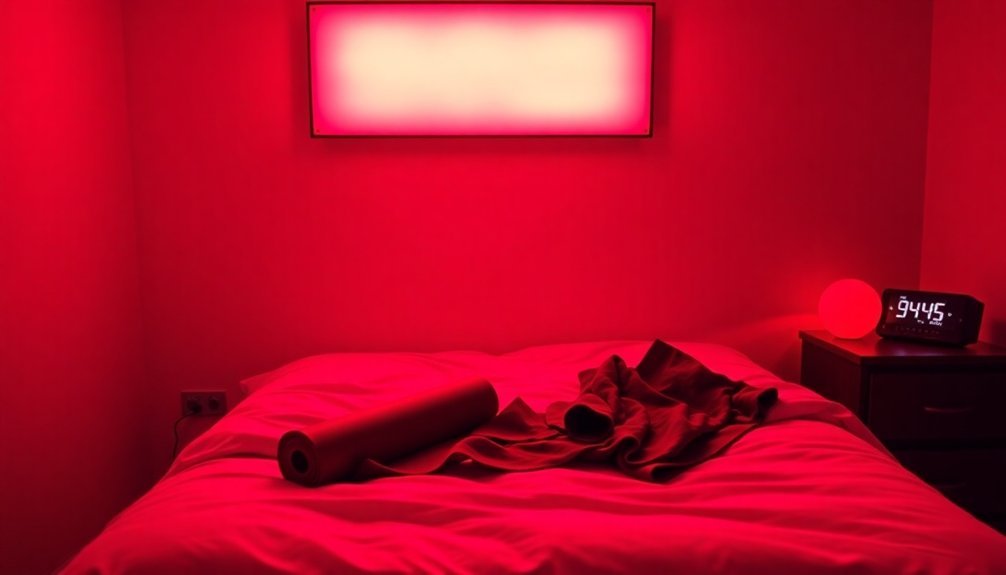
After an intense workout, you'll want to allow your muscles at least 30 minutes to cool down before starting your red light therapy session.
During this post-exercise window, your body's natural recovery processes begin working alongside the therapy's muscle-repairing benefits, creating an ideal environment for healing.
When you combine this recovery timing with your bedtime routine, you're setting yourself up for enhanced sleep quality while supporting your body's overnight muscle repair mechanisms.
Post-Workout Cool Down Period
Sweaty athletes understand that stopping exercise abruptly can lead to unwanted side effects. Your body needs a proper cool-down period lasting 3 to 10 minutes, depending on your workout intensity.
During this time, you'll want to focus on bringing your heart rate and blood pressure back to normal levels through low-intensity movements like walking or light cycling.
A proper cool-down isn't just about feeling better – it's vital for your body's recovery and long-term performance. You'll help remove lactic acid buildup, prevent muscle soreness, and reduce your risk of injury.
For the best results, incorporate static stretching and foam rolling into your cool-down routine while maintaining steady breathing.
- Start with 3-5 minutes of light cardio at a decreased intensity from your workout
- Follow with static stretching, holding each stretch for 15-30 seconds
- Use a foam roller on major muscle groups to break down tight spots
- Focus on deep breathing while your heart rate returns to normal.
Muscle Recovery Support Timing
Most athletes understand that proper recovery timing can make or break their fitness goals. Red light therapy (RLT) offers a powerful way to accelerate muscle recovery, particularly when you time it correctly after your workouts. You'll get the best results by using RLT immediately after exercise for 10-20 minutes, as this helps reduce inflammation and increase blood flow to your muscles.
| Timing | Benefits | Duration |
|---|---|---|
| Pre-workout | Prevents injury, boosts performance | 10-20 mins |
| Post-workout | Reduces soreness, speeds recovery | 10-20 mins |
| Before bed | Enhances sleep, promotes healing | 15-30 mins |
To maximize your recovery, you'll want to combine RLT with other recovery practices like proper nutrition and hydration. For the best possible results, aim for 3-5 sessions per week when focusing on specific muscle groups, or 1-2 sessions for general maintenance. You can also use RLT before bed to support your body's natural recovery processes during sleep. Remember to monitor your training intensity and adjust your RLT sessions accordingly. If you're experiencing increased stress levels, you might need additional recovery time between sessions.
Enhanced Sleep-Exercise Connection
The combination of exercise and red light therapy creates a powerful synergy for optimizing your sleep quality. When you engage in physical activity and follow it with red light therapy, you'll experience enhanced melatonin production and reduced inflammation, both essential factors for achieving restorative sleep.
This therapeutic approach helps maintain your circadian rhythm while accelerating tissue healing and reducing muscle soreness.
For athletes and fitness enthusiasts, the sleep-exercise connection becomes even more critical. Red light therapy after workouts doesn't just improve recovery – it sets you up for better sleep quality, which in turn enhances your athletic performance and endurance. You'll wake up feeling more alert and ready for your next training session, as the therapy effectively reduces sleep inertia.
- Apply red light therapy for at least 15 minutes post-exercise to maximize recovery benefits
- Use wavelengths between 640-950 nm for ideal tissue penetration and healing
- Target a power output of 10-35 mW per LED for effective treatment
- Consider timing your sessions 2-3 hours before bedtime to enhance natural melatonin production
Late Work Schedule Adjustments
Managing late work schedules requires understanding both employer rights and employee protections under various labor laws. While employers generally have the right to change work schedules without notice under the Fair Labor Standards Act, you'll find that some states enforce strict predictive scheduling laws that protect workers from last-minute changes.
If you're working in New York City, your employer must provide 72 hours' notice for schedule changes, while Oregon requires 14 days' advance notice. In San Francisco, you're entitled to increased pay if your employer changes your schedule without a 7-day notice. If you live in California and get sent home early from a scheduled shift, you're eligible for reporting time pay.
When facing late schedule adjustments, you can take proactive steps to protect yourself. Start by discussing scheduling concerns with your supervisor and HR department, clearly communicating your constraints such as childcare needs or transportation requirements.
If you're experiencing frequent last-minute changes that disrupt your personal life, document these instances and familiarize yourself with your state's specific labor laws to understand your rights and available protections.
Shift Worker Light Exposure
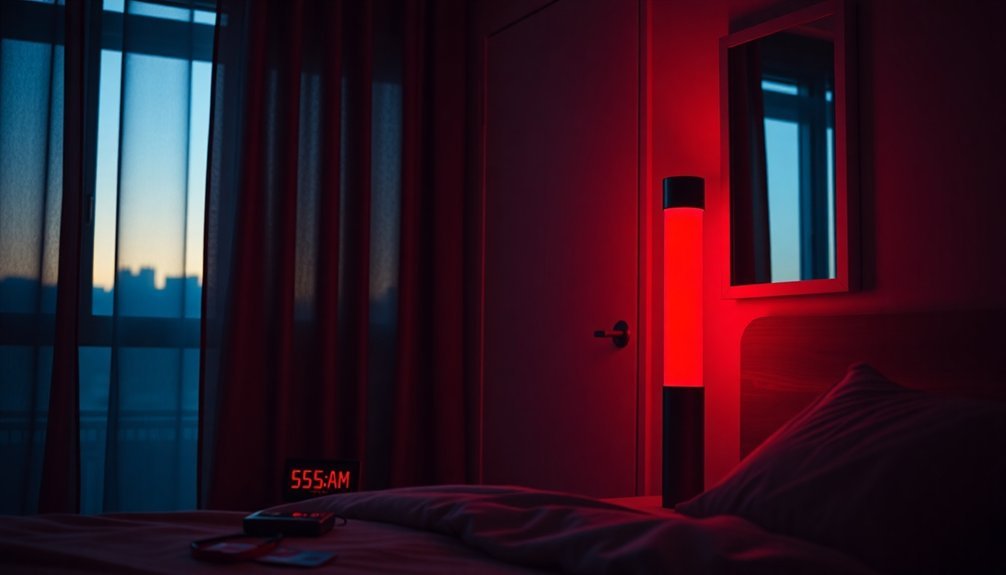
Beyond adapting work schedules, shift workers face substantial challenges from disrupted light exposure patterns. If you're among the 15-20% of workers following non-traditional hours, you'll need to carefully manage your light exposure to protect your health and maintain alertness during shifts.
Research shows that while blue light disrupts your natural melatonin production, red light therapy can help you stay alert without compromising your circadian rhythm. You'll find that strategic use of red light during night shifts can improve your performance similar to caffeine, while preserving your body's natural sleep-wake cycle.
- Use red light during night shifts to maintain alertness without suppressing melatonin
- Avoid bright blue light exposure when you're trying to maintain your natural sleep rhythm
- Consider ambient red lighting in your workspace to support sustained performance
- Time your light exposure carefully to match your shift schedule and sleep goals
Given the high risks of health issues associated with shift work, including cancer, metabolic disorders, and cardiovascular disease, it's essential to implement proper light management strategies. Your careful attention to light exposure can markedly reduce these health risks while maintaining your work performance.
Implementing these strategies is crucial because shift work is linked to various health issues. For instance, shift work can increase the risk of cancer, metabolic disorders, and cardiovascular disease. By managing light exposure effectively, you can mitigate these risks and ensure better overall health and work performance.
Pre-Sleep Wind Down Routine
Establishing a proper wind-down routine 30-120 minutes before bed can substantially enhance your sleep quality and overall well-being. You'll want to create a consistent schedule that signals your body it's time to shift from wakefulness to rest, helping reinforce your natural sleep-wake cycles.
Start by dimming your lights and limiting screen exposure to reduce blue light. You can choose from several relaxing activities: practice deep breathing exercises like the 4-7-8 method, perform gentle stretches, take a warm bath, read a book, or write in your journal.
These activities help reduce stress and anxiety while preparing your mind and body for restful sleep.
Create a calm environment that supports your wind-down routine. You might incorporate soft music, aromatherapy, or other soothing elements that work best for you. Don't be afraid to experiment with different combinations of activities to find what's most effective for your needs.
Remember to monitor your responses to various wind-down activities and adjust your routine accordingly. When you maintain consistency with your pre-sleep routine, you'll likely experience improved memory recall, better mood, and feel more prepared for the next day.
Mindful Light Session Timing
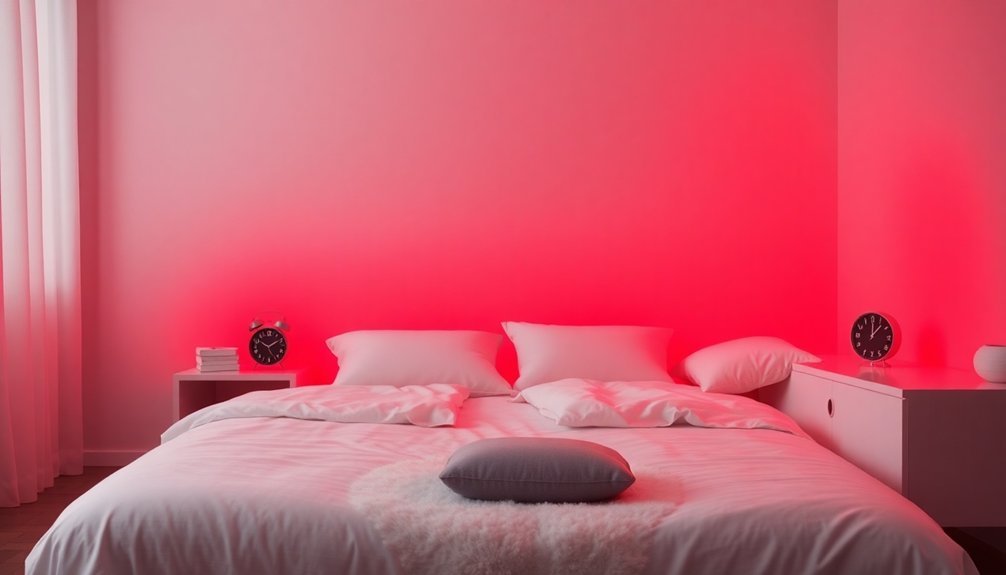
Timing your red light therapy sessions in accordance with your body's natural rhythms can substantially impact their effectiveness. While morning sessions boost energy and enhance performance, evening sessions about 30 minutes before bedtime are ideal for promoting relaxation and improving sleep quality.
You'll want to maintain consistency with your sessions, as this helps train your brain to associate red light therapy with relaxation and sleep preparation.
The best duration for your evening red light therapy session is 10-20 minutes. You'll find that shorter sessions may not deliver full benefits, while longer ones could lead to overstimulation.
To maximize the effectiveness of your sessions, consider these key timing principles:
- Schedule your session at the same time each evening to establish a routine
- Allow a 30-minute window between the session and bedtime for melatonin production
- Combine your session with other relaxation techniques like deep breathing
- Keep morning sessions for energy and evening sessions for sleep enhancement
Remember to position the light at a comfortable distance and avoid looking directly at it. For best results, create a calm environment and consider using soft background music during your session.
Seasonal Light Therapy Planning
While evening red light therapy supports better sleep, a thorough approach to light therapy throughout the year can help manage seasonal mood changes. You'll want to start planning your light therapy regimen several weeks before your symptoms typically appear, especially if you're among the 20 million Americans who experience SAD.
Begin by establishing a morning routine with your light therapy box, positioning it 16-24 inches from your face within the first hour of waking. You'll need 30-40 minutes of daily exposure to full-spectrum light that mimics natural outdoor light.
It's essential to combine this with increased exercise as summer ends to maximize the benefits.
For the most effective results, you'll want to integrate your light therapy with other treatments. Consider pairing it with cognitive behavioral therapy and regular exercise.
If you're dealing with bipolar disorder or eye problems, consult your healthcare provider before starting light therapy. While most insurance won't cover the cost of a light box, investing in one can be worthwhile.
Remember to monitor your symptoms and seek professional help if they don't improve when spring arrives.
Frequently Asked Questions
Can Red Light Therapy Be Done While Lying in Bed?
You can use red light therapy while lying down, whether on a specialized therapy bed or by positioning panels near your regular bed. However, you'll need proper setup and positioning for effective treatment.
Should I Keep My Eyes Open or Closed During Sessions?
You can choose either option – keeping your eyes closed promotes deeper relaxation and reduces distractions, while keeping them open maintains visual acuity. If you're sensitive to light, it's better to close them.
Will Medications Affect the Timing of Red Light Therapy?
You don't need to adjust your red light therapy timing based on medications, as there's no documented interaction. However, if you're concerned, consult your healthcare provider about your specific medication regimen.
Can I Use Multiple Red Light Devices Simultaneously?
Yes, you can use multiple red light devices simultaneously. It's safe and may enhance therapeutic benefits by targeting different areas at once. Just guarantee the devices are compatible and follow recommended dosage guidelines.
Does Room Temperature Impact Red Light Therapy Effectiveness?
Room temperature won't substantially impact your red light therapy's effectiveness unless it exceeds 41°C. You'll achieve best results at normal room temperatures, as the therapy itself only causes minimal heat increase during treatment.
In Summary
You've now got the tools to optimize your red light therapy timing for better sleep. Whether you're adjusting to shift work, fighting seasonal changes, or simply seeking deeper rest, you'll find these five strategic windows incredibly effective. Remember, consistency is key – stick to your chosen timing and you'll soon notice improved sleep quality, enhanced melatonin production, and a more balanced circadian rhythm. Try it tonight and see the difference.

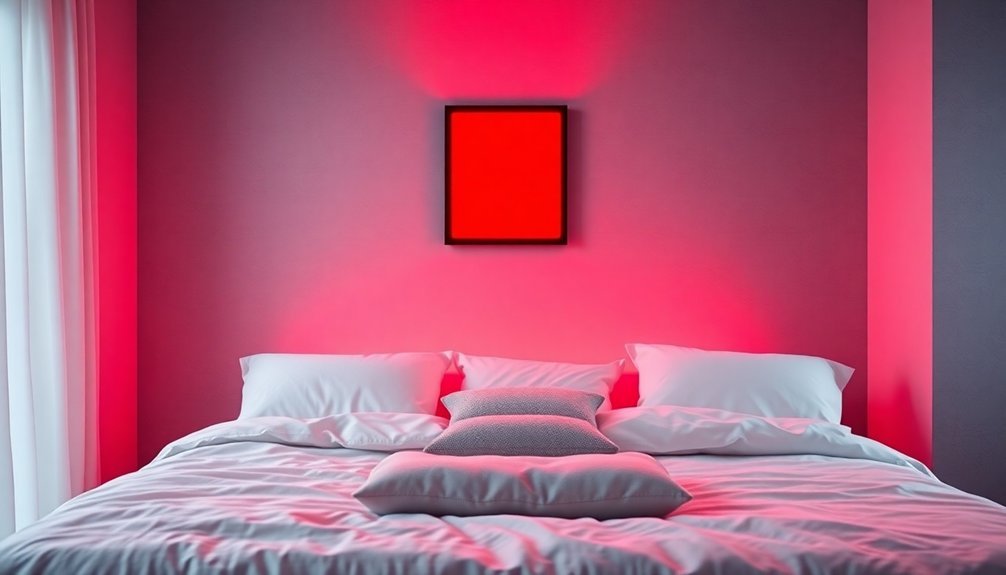



Leave a Reply